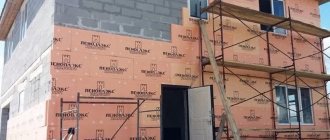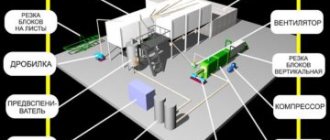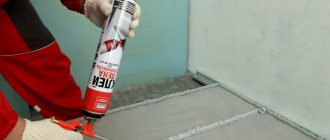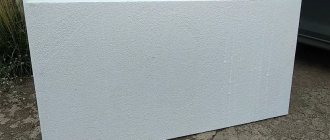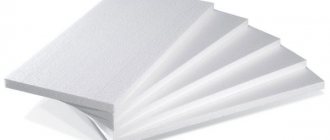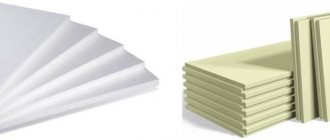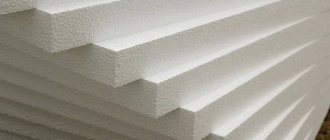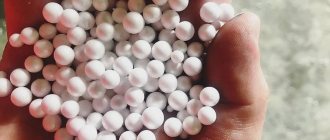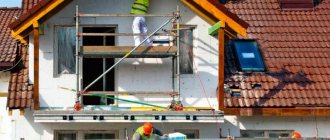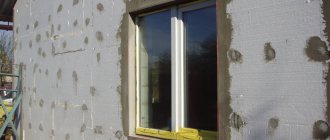In modern construction, both foam plastic and extruded polystyrene foam are used as insulation, and quite often the question arises - which is better: foam plastic or extruded polystyrene foam.
Expanded polystyrene is one of the types of polystyrene foam. But if we talk about each material separately, we can highlight the following advantages of these materials.
What is extruded polystyrene foam
The complex technical name of the insulation alarms many who prefer to use only environmentally friendly, low-flammable materials in insulating their homes. Modern technologies make it possible not to use freon as a foaming agent. Therefore, only CO2 or freons are now used for polystyrene foam granules. So we can well call it environmentally friendly.
The material has a number of characteristics that make it very attractive for private and low-rise construction, as well as for use on an industrial scale.
- The insulation does not have a biological component, so it does not rot or decompose. Such properties make it durable (service life ≥ 50 years).
- Eco-friendly insulation. Moreover, we can even talk about the environmental friendliness of its production.
- It has proven itself well in underfloor heating systems. The entire “warm floor” structure is mounted on top of penoplex 35. A low thermal conductivity coefficient will effectively save heat, due to which the cost of heating a house or apartment is significantly reduced.
- Wide range of applications. The insulation can be used both in a country house and at an airfield.
Technical characteristics of penoplex are presented in the table below.
How is extruded styrofoam produced?
The disadvantages of conventional polystyrene foam are its low load-bearing capacity and relatively high water absorption, which can reach up to 14 percent. This greatly limited the range of applications of expanded polystyrene. So, it is not suitable for insulating underground structures. And insulating precisely these parts of buildings provides a very high economic effect.
In addition, not all types of expanded polystyrene can be used for installing floor screeds with high load capacity, for example, in workshops of industrial enterprises. Or in places where underfloor heating systems are supposed to be installed.
In order to solve all these problems, a technological mode was developed that makes it possible to obtain high-density polystyrene foam with almost completely closed cells, but at the same time having a high density and a record low thermal conductivity coefficient.
The pioneers in the development of the technology of extruding styrofoam granules were the USA and Germany, where the production of high-density polystyrene foam was started at the factories of TheDowCo (USA) and BASF AG (Germany). The production technology of extruded polystyrene foam is very different from the production technology of conventional expanded polystyrene. First of all, the fact that the initial raw material - polystyrene granules - melts completely at high temperature under pressure and is fed into an extruder - a mixing device with foaming agents, from where the material is supplied for molding, while continuing to expand.
Initially, rigid and ordinary freons were used as foaming agents. But as the understanding of the danger of their use for the Earth’s ozone layer came, all manufacturers of this material switched to technologies with carbon dioxide instead of freons.
A distinctive feature of extruded polystyrene foam is the presence in the structure of the dense substance of numerous closed cells with gas. This gives it high heat-saving qualities and reduces water absorption to zero. Moreover, the size of the cells is so small that it is impossible to see them with the naked eye. We are talking about cells with a diameter of about 100 microns.
Today Russia has its own factories for the production of this important insulation. The leader and discoverer of this amazing material was the Penoplex company
Therefore, in our country, all extruded polystyrene foam bears a generic name from this company. Penoplex's competitor is TechnoNIKOL, a company that produces roofing and insulating materials. A significant share of extruded polystyrene foam continues to come from the European Union and China. Since Russia's need for this insulation is very great.
We study the flammability of penoplex
Penolex is a type of thermal insulation material, which is extruded polystyrene foam. Most people, when choosing suitable insulation for their home, are guided by the various characteristics of the material. Many are interested in low price, some prefer ease of installation, and only a small part think about environmental safety and fire resistance. What characteristics does penoplex have? Is it combustible or absolutely non-flammable? It’s strange, but there are a lot of opinions about this indicator, so it’s worth taking a closer look at the fire safety of penoplex.
What is the difference
If you conduct a comparative analysis between polystyrene foam and extruded polystyrene foam, then at first glance there is not much difference between them. They are made from the same material, but the production technology and density are different. And the main difference between them is the scope of application. Polystyrene is allowed to be used for thermal insulation of a base with a width of 20-30 mm, but the thickness of the foam should be 50 mm. You can read about the pros and cons of polystyrene foam ceiling tiles in the article.
The video shows the difference between polystyrene foam and extruded polystyrene foam:
You may also be interested in learning about the thermal insulation properties of polystyrene foam.
But what is the price of Penoplex insulation for the outside walls of a house and where such material can be used is described in this article.
You can see how the foam ceiling plinth is glued in the video in this article.
But what are the characteristics of extruded polystyrene foam Penoplex that currently exist is described in this article.
Maybe
Pipes with flammability group G1
These pipeline systems have passed specialized tests and have a certificate of flammability group G1 - this ensures the possibility of their use in fire-hazardous premises, basements, risers, warehouses, automatic fire control systems and fire-fighting water supply systems.
Italian silent sewer pipes are the most cost-effective silent sewer!
- Noise absorption - 12 db
- Non-flammability - flammability group G1
- Pressure - adhesive connection - 10 atm
- Non-pressure - socket connection - 3 atm
Installed at the 2018 FIFA World Cup stadiums
Officially approved plastic pipe system in the field of automatic fire extinguishing. Designed specifically for sprinkler systems.
Certified according to established fire safety standards in most countries of the world, as well as by VNIIPO EMERCOM of the Russian Federation for use in fire control systems and fire-fighting water supply systems. Does not require washing, flame retardant.
Penoizol - polystyrene foam based on urea-formaldehyde
In addition to polystyrene, other polymers are also used in the production of foam plastics. Material based on urea-formaldehyde has become widespread. It is more often called penoizol. The production of penoizol is quite complex, and in our country it was not widely used in construction until the 90s of the last century.
The process of making penoizol consists of creating foam and enveloping the cells with karmamide resin. The material hardens within 2-3 days and acquires excellent characteristics - the material is quite dense and has low thermal conductivity.
Penoizol is produced in the form of standard slabs, but is most often used in construction work in a liquid state - during the preparation process at the workplace. This has great advantages in terms of installation work:
- Filling the hardest-to-reach places with thermal insulation
- There is no need for preliminary calculations for the purchase of materials
- No additional fasteners
However, the use of penoizol during the construction process requires special equipment. It is clear that in this case, only specialized teams can carry out the insulation work.
Spraying penoizol requires special equipment
Selection of material depending on the conditions of use
When choosing a material for various types of construction work, you should be guided by the following considerations:
- When arranging external thermal insulation for the walls of a building, it is better to use polystyrene foam, which has better vapor permeability than penoplex, and the heat saving characteristics of these materials are similar.
To insulate the foundation, of course, you need durable penoplex
- It is better to treat the foundation of the house and its basement with penoplex, as it will protect these elements of the building structure from deformation by soil pressure and the aggressive effects of groundwater.
- For insulating balconies and loggias, you should also prefer penoplex, since you can use a thinner layer of protective material.
- Attics and attics on the roof side can be insulated with any material, but on the floor, if people will move on it, you need to lay foam boards. In this case, you don’t even need to equip additional coverage.
To insulate the basement floor, it is better to choose penoplex
The choice of insulation must be made based on the conditions in which it will be used and based on financial capabilities. In some cases, the use of cheaper foam is quite sufficient.
As a result, we can conclude that the choice of a specific material for insulation is determined by the conditions of its use. The following video offers several practical experiments in the use of the insulation materials discussed.
Safe for me, safe for you
It is impossible not to compare both materials in terms of their impact on the environment and interaction with it. Who to give preference: penoplex or technoplex?
The fire hazard of the materials is the same. They belong to the category of substances that support and spread combustion. When they burn, a gas that is unsuitable for breathing is released into the atmosphere. Because of this, they are not recommended for use as insulation without taking additional measures to ensure fire safety, for example, treating them with thermite.
The chemical and biological activity of these insulation materials is the same due to the use of the same source material: they are not afraid of contact with most building materials and solutions, are not attacked by insects and rodents, do not rot or spread fungus.
Both materials are destroyed under the influence of ultraviolet radiation, so their use without shelter is not recommended.
Ease of installation
When choosing polystyrene foam and expanded polystyrene, it is recommended to pay attention to one feature of the appearance of the slab of the second candidate. The side surfaces have L, S-shaped protrusions
This results:
- to the formation of a continuous layer of insulation without the formation of cracks and gaps;
- obtaining a more rigid and time-stable thermal insulation field;
- increasing installation speed.
Polystyrene foam has smooth side surfaces, which leads to the need for additional work on the insulated surface. This is expressed by filling the joints with adhesives or polyurethane foam.
The technologies for installing the slabs and the materials used for fastening are identical.
Method of obtaining
Foams are a class of polymers (plastics) that contain air cells between the chains of an organic matrix. If the microcavities are connected to each other, the product is called a foam plastic.
Foams are produced by mixing large polymer molecules or medium oligomer molecules with solid blowing agents, low-boiling liquids or an inert gas.
There are technologies in which gas is formed during a chemical reaction of organic raw materials. The foamed product is shaped by cooling or special curing techniques.
There is a modification of expanded polystyrene obtained by polymerization of the monomer. The resulting polymer is mixed with additives that form pores. The resulting mixture is passed through an extruder.
The result is a high-density foamed styrene polymer. Extruded polystyrene foam, often called penoplex. This is a product with good thermal insulation ability. It can be used to insulate houses even in the Far North.
Among foam products, polyurethane foam, also known as foam rubber, is very popular. It is obtained by foaming a liquid reaction mixture of monomers with the addition of organosilicon components, foaming agents (water or freon), and substances with high surface activity.
By varying the process conditions, polymers of varying rigidity can be obtained. They have conditionally non-flammable properties. Foamed polyurethane products with a reinforced matrix are used as insulation materials.
Application area
Due to its high density, durability and insulating ability, polystyrene foam is used mainly as a thermal insulation material, but polystyrene foam finds many more applications and is better suited for the following areas:
- Watercraft, boats, lifebuoys.
Video about what polystyrene foam is and how it is produced:
- Dielectric products.
- Furniture elements.
- Packaging containers.
- Blanks.
Polystyrene foam can also be used as insulation, provided there are no damaging loads, protection from rodents and fire.
Flammability class
The closest analogue of polyurethane is classified as flammability class G2. This fact can be completely trusted, since the insulator contains nitrogen. But the assurance that polystyrene foam has the same flammability and belongs to the same class is most likely an advertising ploy. According to the generally accepted classification, this insulation is defined as follows:
- NGA, G1 and G2 are non-flammable, slightly and moderately flammable materials; the fire safety characteristics of penoplex can hardly be attributed to these classes;
- G3 - insulation materials with normal flammability parameters; this class includes polystyrene foam with the addition of fire retardant and other components;
- G4 is a conventional polystyrene foam insulation with highly flammable properties.
Some manufacturers claim that they have switched to the production of a brand of penoplex with a G1 flammability class, but this is physically impossible. The first two groups include materials that do not splash into droplets when burning. Polystyrene heat insulator does not have such qualities. Supporting videos of a suspended sample cannot serve as real evidence, since the penoplex droplets flow downwards through natural gravity.
You can compare the flammability of various thermal insulators with polystyrene foam in this video:
Comparison
Expanded polystyrene 30 mm
Each of the materials mentioned has its own properties. First, let's touch on the most significant characteristic - thermal conductivity. In this regard, the advantage of polyurethane foam is noted. Moreover, it is important that it is produced not only in the form of panels, but also as an aerosol product that is sprayed onto objects. If polyurethane foam is used in this way, a monolithic coating is obtained that exactly follows the topography of the base.
Expanded polystyrene does not require such an effective application method. It is mounted to the surface in the form of solid slabs. The gaps between them cause heat leakage and deterioration of sound insulation. The difference between polystyrene foam and polyurethane foam is that it does not interact well with adhesives and plaster compositions. Meanwhile, polyurethane foam can be firmly fixed to the surface. In addition, this material absorbs moisture less, which has a positive effect on heat conservation.
It is worth noting that polystyrene foam begins to disintegrate and release hazardous substances at a lower temperature - approximately sixty degrees Celsius. Therefore, it is not recommended to insulate the roof with it, especially in the southern regions with the scorching sun. As for the fire safety indicator, the materials discussed themselves do not burn for a long time. But if there is a constant source of fire, then polystyrene foam quickly becomes engulfed in flames. The process is accompanied by the separation of melting fragments and the saturation of the air with a large amount of toxins. The second material burns worse.
What is the difference between polystyrene foam and polyurethane foam regarding their service life? Here the second type of product wins again. Polyurethane foam retains its beneficial qualities much longer. This is partly due to the fact that it is not subject to deformation. Expanded polystyrene is compressed over time, and its thermal insulation properties noticeably deteriorate. As a result, polyurethane foam is the leader in all respects. It is not surprising that the price is higher.
Modern living conditions do not allow relaxation. Harsh winters and high energy prices make us think about saving. Energy resources can be saved by insulating walls. Foamed polystyrene is perfect for this. Experience shows that high-quality wall insulation can save from 30 to 60 percent of electricity. Of course, heat retention is influenced by factors such as average temperature, the material used to insulate the surface, the insulation method, etc.
Manufacturers
There is fierce competition in the construction market, however, not as many companies are involved in the production of technoplexes as the consumer would like. Let's consider the list of the main suppliers of extruded insulation on the Russian market.
TECHNONICOL. The company is among the TOP 100 largest enterprises in Russia, and has several production lines in the country. The manufactured products attract buyers with a relatively low price and high quality.
URSA. A relatively young brand that appeared on the market in 2003. At the beginning of its development, the company was engaged in the production of mineral wool from fiberglass. After merging with the Spanish company URALITA, lines for the production of extruded polystyrene began operating. Now it is one of the leading European brands, actively developing the Russian building materials market.
RAVATHERM. The trademark belongs to a Belgian company with production lines in the Moscow region. Finished products are subject to multi-stage quality control, so they invariably have high technical characteristics.
It is worth noting that the products of these enterprises have international certificates and are absolutely environmentally safe.
Insulating a house - what material to choose?
The warm season is exactly the time when it is necessary to solve global construction issues. The most important of which is façade insulation. This question is asked by both apartment owners and private home owners. Both new buildings and houses about 50 years old are insulated. When you have already decided to insulate your house, the question immediately arises, which confuses many, what to choose from these two materials.
Description
Density
High-quality EPS has a homogeneous structure and closed pores of a much smaller size than conventional polystyrene foam (no more than 0.2 mm). Due to its increased compressive density, EPS can be used where foam plastic is too soft. Extruded polystyrene foam can withstand a load of 35 tons per 1 m2!
Installation work
Another advantage that this material structure provides is the ability to process it comfortably. Many people know how difficult it was to cut foam plastic. The balls crumbled, scattered and became magnetized to hands, tools and surfaces. And even with careful handling, the slab could crack and break in the wrong place.
House insulation with Penoplex
Extruded polystyrene foam is free of all these disadvantages. It is easy to cut with a regular hacksaw. The cut is precise and even. And the slabs are laid directly on the base - no additional layers of steam and waterproofing are required. The joints are sealed with polyurethane foam. EPS does not emit toxic substances or unpleasant odors. Working with it does not require special equipment for installers.
Moisture absorption
The dense structure increased the moisture resistance of the material (against the background of vulnerable mineral wool, water absorption of 0.2 looks like an error). In the first 10 days, the side cells on the cut collect a minimal amount of moisture. Then water absorption stops, water does not pass inside.
Thermal conductivity
In the battle to retain heat, even a slight difference in thermal conductivity matters. For different brands of expanded polystyrene, this figure ranges from 0.037 to 0.052 W/(m* °C). Extruded polystyrene foam has an indicator of 0.028 - 0.03 W/(m* °C)!
Chemical resistance
XPS has proven to be resistant to:
- various acids (organic and not);
- salt solutions;
- ammonia;
- cement and concrete;
- lime;
- alkalis;
- alcohol dyes, alcohol;
- carbon dioxide, oxygen, acetylene;
- freons (fluorinated hydrocarbons);
- paraffin;
- water and water-based paints;
- bacteria and fungi.
Other properties
The thickness of the produced slabs can be from 2 to 12 cm.
For ease of installation, three types of edges are available:
- Straight.
- With the selected quarter (marked with the letter S).
- Tenon - groove (letter N on the marking).
The outer surface can be smooth or corrugated (indicated by the letter G on the marking).
The color range of extruded polystyrene foam is varied. There are no uniform standards yet, so each manufacturer produces slabs of different sizes, thicknesses and different colors to indicate different quality EPS.
The properties of EPS do not change even after 1000 freezing-thawing cycles, or after prolonged immersion in water. Extruded polystyrene foam remains unchanged even in conditions of -60 +85 °C!
Orange slabs
Cons and weaknesses:
- Penoplex is vulnerable to solvents, some gases (methane), petroleum jelly, tar, gasoline, oil and fuel oil.
- Susceptible to destruction upon contact with polyvinyl chloride (siding).
- Flammability. It corresponds to the level of flammability of wood, but all foam plastics emit toxic substances when melted that suffocate a person faster than carbon monoxide.
- The material must be protected from direct exposure to ultraviolet radiation (not used open).
- There are temperature restrictions when insulating baths, saunas and fire pits. The surface should not be heated above +75 °C.
- Just like polystyrene foam, extruded polystyrene foam can be damaged by rodents. They don't eat it, but grind it up and build nests in it.
There are no ideal materials, therefore, knowing about its shortcomings, you need to be able to adjust technologies to suit them. For example, in order to protect residents in case of fire, it is not recommended to use EPS for internal insulation of ceilings, and plastering should be done on top of the insulation layer.
To protect the wall from rodents, Penoplex slabs can be covered with fine mesh.
Special purpose insulation
A unique combination of useful properties (high compressive strength and low water absorption) allows the use of EPS in non-standard schemes for other insulation materials. Since the material does not absorb moisture, when making floors on the ground, it can be laid directly on the ground. This solution is not only easier to implement, but also cheaper than laying EPS on a concrete screed. In fact, in this case, a screed is not needed; it is enough to simply level and compact the soil well.
When insulating foundation walls, EPS can be used without additional waterproofing from the outside. This material is one of the most reliable and convenient for insulating the underground part of a building, where it is quite difficult to perform reliable waterproofing of the insulation, and its repair is very expensive.
With the advent of EPS, it became possible to create reliable, serviceable roofs. This material is laid with the reverse order of layers of the roofing pie (inversion roofs). In this case, the waterproofing layer is laid directly on the ceiling, and on top of it are slabs of extruded polystyrene foam, protected on top by paving slabs, terrace covering or gravel. Some manufacturers (Roofmate, etc.) produce special EPS with a protective layer.
Waterproofing in inversion roofs lasts much longer than when it is the topmost layer exposed to ultraviolet radiation and temperature changes. On inverted roofs you can create lawns and even gardens. To do this, geotextiles are laid on top of the insulation boards and a layer of fertile soil is poured, which at the same time serves as a pressure ballast layer.
Differences between polystyrene foam and polystyrene foam
Expanded polystyrene is produced differently. I melt the granules and process them. The result is a denser “coupling” formed at the molecular level. No air bubbles form between the “clusters” of polystyrene beads.
Secondly, there are some differences in the characteristics. This logically follows from different production methods. Expanded polystyrene has its advantages compared to polystyrene foam. Namely:
- increased strength. Since this material is a single mass of molten polystyrene granules, its strength is significantly higher. Foam plastic, as everyone has noticed, crumbles easily. And if you bend it, the sheet will simply break. This will never happen with polystyrene foam. Technically speaking, polystyrene foam is 6 times less flexurally strong than expanded polystyrene.
- permeability. Polystyrene foam, as already mentioned, has air bags. As a result, this material can absorb more moisture than its older brother. The same applies to sound permeability; for foam plastic this indicator is much worse, which means that noise can penetrate into rooms more freely.
- density. Expanded polystyrene is almost five times denser than polystyrene foam. This makes it a little heavier, but still keeps the weight at a minimum. But the increased density makes polystyrene foam several times stronger.
- thermal conductivity. Since polystyrene foam is denser, its thermal conductivity is lower.
In almost all characteristics, polystyrene foam is inferior (albeit slightly) to its older brother. In addition, polystyrene foam costs a little more. But in principle, both materials are excellent insulators and are widely used in thermal insulation work.
Let's compare density and thermal conductivity
Differences in production affect the properties acquired by thermal insulators. Their quantitative and qualitative indicators make it possible to determine how one material differs from another.
The main defining characteristic is density. For foam plastic it ranges from 15 to 35, and for expanded polystyrene – from 28 to 45 kg/m3
This has a rather strong effect on an important characteristic of insulation - the specific thermal conductivity coefficient. It is the density of the insulator that determines what is warmer and what retains heat better
The difference between polystyrene foam and expanded polystyrene in this category reaches 0.12 units in favor of the latter. A denser structure allows you to retain more heat, and therefore be the most advantageous in this regard.
The weight of 1 m3 of insulation depends on the density. But this characteristic is not decisive when choosing, so it can not be considered when evaluating.
Foamed polystyrene what is it
Penoplex is produced by the company of the same name. It creates insulating material using a special technology: extruded polystyrene is foamed under high pressure. The same applies to the technology for creating Technoplex, according to open sources. It is produced by TechnoNIKOL. As for the remaining details of the process of creating Penoplex and TechnoNIKOL insulation, nothing is reported about them. True, fragmentary data leads us to the following thoughts:
- Polystyrene granules, which act as the main raw material, are mixed with the gasifier. The mixture is heated to a high temperature and pressed through small holes. In this case, polystyrene granules must be highly purified.
- As the mixture passes through the micro-hole nozzle, the flow begins to break up into microscopic threads. In this case, the polymer molecules are pulled out and form a connection with each other. And thanks to pressure, they begin to harden.
- When the polypropylene comes out of the nozzle, it begins to foam and forms a porous material with thousands of small bubbles.
It turns out that based on the technology of creation, it cannot be said that Penoplex or TechnoNIKOL is better. They are almost the same, the difference lies in composition and strength. According to the TechnoNIKOL company, the composition of their products, namely Technoplex, is enriched with amphora carbon or graphite. In this case, the rolling rollers can better form the material into its final shape and thickness.
So, Penoplex is made by extrusion. And Technoplex, thanks to the inclusion of graphite nanoparticles, increases the strength of the material, and its thermal conductivity coefficient decreases even more. Both the first and second materials are environmentally safe. They are safe and non-flammable. The materials will not dissolve in water or soil.
Conventional production technology involves the use of light freons mixed with carbon dioxide as a vapor-forming gas. As for new creation methods that are much better. For their implementation, liquid and powder gas-forming agents are used.
Comparison of materials by main characteristics
Polystyrene foam and penoplex are similar in name; in addition, they are made from the same raw materials and, in essence, are interchangeable. Both of these materials are widely used when carrying out work on insulating elements of building structures; extruded polystyrene foam is considered more modern when compared with polystyrene foam.
Technoplex is penoplex from
A comparative analysis of such performance characteristics as mechanical strength, thermal insulation parameters, ability to resist ignition, service life, moisture absorption properties, the range of temperatures used and other operating parameters - all this will allow you to make the right choice in each specific case. Which is better - penoplex or polystyrene foam? There is no clear answer to this question.
Let's evaluate the thermal insulation parameters
Thermal insulation parameters are determined by the ability of the material to save heat in the serviced space. These qualities of polystyrene foam in comparison with penoplex are somewhat worse due to the fact that polystyrene granules do not adhere to each other as tightly as in penoplex, the pores of which are much smaller due to the greater compaction of this material, as a result of which it is warmer.
Foam plastic was called the more respectable word “insulation”
A 25-millimeter-thick foam board is equal in thermal insulation properties to a 25-mm foam board. This seemingly insignificant difference during large volumes of construction work can significantly increase the space being developed.
What is stronger - polystyrene foam or polystyrene foam?
Penoplex is definitely stronger than polystyrene foam due to the fact that during its production, polystyrene granules are melted to form a homogeneous substance, and polystyrene foam consists of balls with air spaces between them. Penoplex can withstand a compression force of about 0.5 MP, while this figure for polystyrene foam is 0.2 MP.
Penoplex is strong enough and good for floor insulation
Let's compare the water absorption of insulation
Penoplex is more moisture resistant. The water absorption rate of extruded polystyrene foam is about 0.35 percent, while for polystyrene foam this value is already 2 percent. The difference is quite significant. Although water does not penetrate into the polymer particles that make up the foam, small amounts of it can fill the pores between them. The vapor permeability characteristic of polystyrene foam is higher; this indicator is practically absent in penoplex due to the dense structure of this material.
At what temperatures can both materials be used?
Both materials can be used in a wide range of temperatures, with significant fluctuations in the external environment. The characteristics of penoplex and polystyrene foam in this parameter are quite close to each other. Materials lose their performance at temperatures below fifty degrees Celsius. The upper limit for polystyrene foam is seventy degrees, for penoplex - seventy-five.
Which material resists fire better?
Both materials are susceptible to fire when exposed to direct flame. Polystyrene foam burns more slowly, its flammability indicator is designated as G3, a similar parameter for penoplex is G4. The degree of susceptibility to fire is indicated by numbers from 1 to 4: the higher it is, the worse the material resists fire.
Impregnation of insulation materials during their manufacture with substances that prevent fire does not ensure their fire safety; they will burn more slowly, while releasing toxic substances into the environment. It should be noted that penoplex extinguishes faster when ignited; polystyrene foam burns slowly, but for a long time.
It is better to insulate the floor, walls and ceiling of the loggia with penoplex
Service life and what it depends on
The service life of both heat insulators is very impressive, but penoplex has an advantage in this parameter. Its service life is on average about fifty years.
Price difference and what you should pay for
An important factor when choosing a particular building material is its cost. Penoplex is about one and a half times more expensive than polystyrene foam, this is explained by the following: very little raw materials are consumed in the production of polystyrene foam. The performance characteristics of penoplex are better in some cases; moreover, a thinner sheet of this material has the same heat-insulating qualities as a thicker foam plate. It is better to insulate the outside walls of the house with polystyrene foam, as it is permeable to vapors.
Penoplex must be used if the surface being treated will be subject to mechanical stress from people moving along it or must withstand significant weight of the finish. When arranging internal thermal insulation in small rooms, the choice should again be made in favor of penoplex, since you can use sheet material that is twenty-five percent thinner than polystyrene foam.
Production technology
Modern polystyrene foam is produced in the form of slabs, which are produced using a non-press method. Foaming polystyrene is taken as a base and placed in large molds. Next, using the thermal shock method, foam blocks are formed. They are cooled using water, vacuum or naturally. Foam production
Advantages and disadvantages
Like any other material, extruded polystyrene foam has advantages and some disadvantages. It is worth familiarizing yourself with them before purchasing and using them.
Advantages of extruded polystyrene foam:
- Moisture absorption within 0.2%. This indicator means almost complete waterproofness.
- Minimum thermal conductivity. At a standard temperature of 25°C it is about 0.032 W/m*K. If we compare the heat conductivity, the indicators are as follows: 55 cm of brick equals 3 cm of polystyrene foam.
- Withstands deformation well. Can be used for laying under a blind area, or after the foundation.
- Does not react with inorganic chemical reagents.
- Withstands significant temperature changes, the indicators do not change at air temperatures from -50 to +75°C.
- According to the documentation, the material can be used for at least half a century. During this time, the characteristics will not change.
- Environmentally friendly substance. It is used not only as insulation, but, for example, for the production of lightweight disposable plates or other types of cheap tableware. Children's toys are made from it.
- Has minimal weight. A small thickness is enough for good insulation.
In addition to numerous positive characteristics, some disadvantages can be identified:
- comparison with other types of insulation shows that the price of the material is high;
- highly flammable. During the combustion process, harmful substances and black smoke are released;
- destroyed under the influence of infrared rays. To maintain performance characteristics, it must be hidden from direct sunlight;
- Manufacturers assure that rodents will not grow inside the insulation. Indeed, they do not live inside, but often make channels for movement;
- solvents destroy the structure.
In addition to the listed disadvantages, low vapor permeability can be added to them. Sometimes this is a plus, but if you insulate a wooden house, fungi and mold may develop. As a result, an unpleasant odor appears in the home and dampness is constantly felt.
Difference in functional properties based on thermal conductivity
The more efficient the thermal conductivity, the thinner the material can be
What is better to use for insulation - polystyrene foam or polystyrene foam?
Analyzing the capabilities of the materials under consideration, one can note their differences.
The main characteristic of insulation is thermal conductivity.
As it decreases, the efficiency of the material increases and it becomes thinner.
- thermal conductivity figure for polystyrene foam – 0.028 W/μ;
- foam plastic - 0.039 W/μ.
The following facts can confirm this:
| № | Material | Thermal conductivity |
| 1 | Styrofoam | 0,039 |
| 2 | Minvata | 0,041 |
| 3 | Reinforced concrete | 1,7 |
| 4 | Solid silicate brick masonry | 0,76 |
| 5 | Brickwork with holes | 0,5 |
| 6 | Glued laminated timber | 0,16 |
| 7 | Expanded clay concrete | 0,47 |
| 8 | Gas silicate | 0,5 |
| 9 | Foam concrete | 0,3 |
| 10 | Cinder concrete | 0,6 |
By mechanical strength
Expanded polystyrene is less fragile than polystyrene foam
We must not forget that polystyrene foam is a good monolith, and in polystyrene foam the particles are soldered together. This significantly affects the strength of materials.
Expanded polystyrene is resistant to fractures from 0.4 to 1 MPa, its compressive strength is 0.25-0.5 MPa, and polystyrene foam has a standard within the limits of 0.07-0.2 MPa and 0.05-0.2 MPa, respectively .
It is well known that polystyrene foam, when subjected to serious mechanical stress, begins to fragment into small balls and breaks. Expanded polystyrene can withstand heavy loads and temperature changes.
According to the ability to absorb water
Foam absorbs water better, which is a negative sign
This is one of the significant characteristics of thermal insulation materials, and this property should be minimized. As it picks up moisture, the insulation will lose its most important features, swell and, on top of everything else, begin to rot and collapse.
Expanded polystyrene, which has a cellular composition, has zero moisture absorption. By immersing it completely and for a long time in water, you will notice that the absorption of liquid can be up to 0.2% of its volume.
For polystyrene foam, which has a different composition, this characteristic is significantly lower. By immersing it in water for 24 hours, you will notice that the material has absorbed 2% of the volume; in 30 days it will absorb 4%.
According to fire resistance
Flammability is an important component when it is necessary to insulate objects with wooden structures - attics, roofs. It should be noted that both materials are classified as groups with increased combustion ability. For more information about the differences between materials, watch this video:
By susceptibility to shrinkage
Unlike polystyrene foam, polystyrene foam does not shrink
The main disadvantage of any insulation is shrinkage. With this phenomenon, cracks occur that reduce the effectiveness of the process.
When heated, polystyrene foam tends to shrink, so it is not recommended to use it in a “warm floor” system.
If polystyrene foam is used to insulate the facade, it must be covered with white plaster, which protects against ultraviolet rays.
Expanded polystyrene almost does not shrink during use.
According to temperature range
The temperature balance acceptable for working with both materials is from – 50 to + 75 degrees.
If you exceed these values, the material begins to deform.
Polystyrene foam ignites at a temperature of 310 degrees, polystyrene foam - at 450 degrees.
Environmentally friendly
These materials contain absolutely no harmful components, such as freon and phenol. After time, insulation materials do not begin to emit harmful substances; they can be confidently used to insulate public buildings and residential buildings.
By service life
Studies have shown that penoplex, which is installed correctly, can last up to 50 years, maintaining its shape perfectly.
If the financial capabilities of the consumer do not reach its purchase, polystyrene foam can be used. It is, of course, inferior to polystyrene foam in technical characteristics, but will be the best material among cheap insulation materials. For more information about the properties of polystyrene foam, watch this video:
If we take into account all of the above, then the answer to the question: polystyrene foam or polystyrene foam, which is better, is a completely justified answer: of course, extruded polystyrene foam is a step higher than polystyrene foam in all respects.
Styrofoam
In accordance with the generally accepted classification, it has a flammability class of G1, G2. However, it has the ability to smolder slowly, releasing very toxic smoke containing styrene.
Numerous tests carried out with polystyrene foam allow us to draw the following conclusions:
- polystyrene foam has the property of self-extinguishing, which means that in the absence of a constant source of flame it will not burn;
- Most types of foam plastic during the combustion process are deformed only in the part where the open flame was exposed;
- has the ability to smolder, emitting toxic smoke;
- The height of the open fire during combustion reaches a maximum after 3–5 seconds, and then the process of smoldering and self-extinguishing begins.
Features of various substances
It is known that substances can be in different states of aggregation, which are important to take into account when determining the flammability group. GOST provides for classification based on quantitative indicators
If a substance can burn, the flammability group G1 is more optimal for fire safety than G3 or G4.
Flammability is of great importance for finishing, thermal insulation, and building materials. On its basis, the fire hazard class is determined. Thus, plasterboard sheets have a flammability group of G1, stone wool has a NG (does not burn), and polystyrene foam insulation belongs to a flammability group of G4, and the use of plaster helps reduce its fire hazard.
Gaseous substances
When determining the flammability class of gases and liquids, standards introduce such a concept as a concentration limit. By definition, this is the maximum concentration of a gas in a mixture with an oxidizer (air, for example), at which a flame can spread from the point of ignition to any distance.
If such a limit value does not exist and the gas cannot spontaneously ignite, then it is called non-flammable.
Liquid
Liquids are called flammable if there is a temperature at which they can ignite. If a liquid stops burning in the absence of an external heating source, then it is called slow-burning. Non-flammable liquids do not ignite at all in the air atmosphere under normal conditions.
Some liquids (acetone, ether) may flash at 28 ℃ and below. They are considered especially dangerous. Liquids that ignite at 61…66 ℃ and above are classified as flammable (kerosene, white spirit). Tests are carried out in an open and closed crucible.
Solid
In the field of construction, the most relevant is the determination of the flammability group of solid materials. It is preferable to use substances of the flammability group G1 or NG, as they are the most resistant to ignition.
The degree of flammability is determined not by one category, but by several:
- "G"
flammability - "B"
flammability - "D"
smoke generating ability - "T"
toxicity
The combination of these categories determines the fire hazard class “KM”
For a clear example, we present the data in the table:
| Fire hazard properties of building materials | Fire hazard class of building materials depending on groups | |||||
| KM0 | KM1 | KM2 | KM3 | KM4 | KM5 | |
| Flammability | NG | G1 | G1 | G2 | G3 | G4 |
| Flammability | — | IN 1 | AT 2 | AT 2 | AT 2 | AT 3 |
| Smoke generating ability | — | D 2 | D 2 | D3 | D3 | D3 |
| Toxicity of combustion products | — | T2 | T2 | T2 | T3 | T4 |
Now we see, if we are only interested in flammability, let’s say G1, we can purchase materials for finishing KM2, and the fire inspector will insist that the requirement for materials correspond to KM1, i.e. the flammability was not higher than B1, and you will have to dismantle and purchase new material. Although G1 appears here and there, the fire hazard class may be different
Pay attention to this
This is interesting: Ignition temperature: described in general terms
Advantages and disadvantages
Now it’s worth considering what the advantages of one and the other materials are. After all, each of them was invented for a reason and is in demand among consumers.
Styrofoam
The main positive qualities of polystyrene foam include:
- Using it as wall insulation both inside and outside the building.
- Its relatively low price is why it is in demand among consumers.
- The material is quite moisture resistant.
- Has little weight.
- Easy to use and install. In addition, it is easy to cut using a knife or other cutting object.
- Good insulation for foundations.
- Polystyrene foam can be cut at various angles, and any shapes can be cut out of it.
- The material can be painted and plastered.
Polystyrene foam is a good insulation material for foundations. The disadvantages of the material include:
- The thickness of the material used should not exceed 3 cm.
- To better attach the material to the wall, it must be perforated, for example, with a needle roller.
- It is necessary to take care of the fireproof coating for the material.
- When installing foam sheets, it must be completely coated with glue.
- When leveling the sheet, it is necessary to use a moisture-proof putty.
It can be seen that the material has both positive and negative sides. Therefore, before purchasing, you need to weigh the pros and cons so as not to get into trouble.
Expanded polystyrene
Its main advantages are:
- It does not transmit heat well, meaning it remains indoors.
- It does not allow moisture to pass through well, which means that even if the material is exposed to rain for several hours, it will remain dry.
- Despite its artificial origin, it allows the house or any other structure to breathe.
- Not subject to rotting.
- Not affected by fungus.
- Durable. Can last about 50 years.
- The material is good to use as a sound insulator. Because it has a homogeneous structure that muffles and absorbs sounds.
The disadvantages of this material include:
- Price. This material is not the cheapest. This is why many consumers buy polystyrene foam.
- This material is destroyed under the influence of certain solvents.
- Expanded polystyrene is susceptible to destruction by rodents. It is quite easy for them to build passages and houses in the material.
- Just like polystyrene foam, polystyrene foam is a flammable material. Therefore, it is necessary to take care of safety. Cover it with a special solution.
It can be seen that the positive aspects of expanded polystyrene are quite attractive, in some cases even better than those of polystyrene foam. However, the main and sometimes decisive disadvantage is the high price of the material.
Let's summarize
Considering polystyrene foam or expanded polystyrene as a heat insulator, it is definitely impossible to say that it is better. It is necessary to make the choice consciously, based on the specific conditions of the availability of funds, transportation, installation and operating conditions.
If we abstract from the surrounding world, then the analysis carried out will help to draw certain conclusions.
During the comparison, the goal was to show as objectively as possible the disadvantages and advantages of common heat insulators. Help everyone make choices that will not make them regret them over time.
